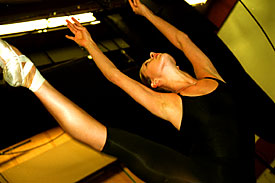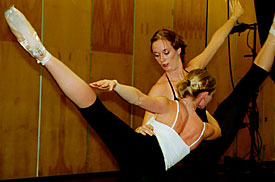 |
|
MELISSA O'NEAL/Arizona Daily Wildcat
|
Sara Hoenes, fine arts major, practices in the Gittings Building for an upcoming performance titled "Spring Collection." The performance is part of a series performed over a four day period starting May 1.
|
|
By Nate Buchik
Arizona Daily Wildcat
Monday April 28, 2003
On the east end of campus, removed from the Student Union Memorial Center and the masses trudging to and from various buildings, 50 students are in class. The classroom has no desks, and the students move gracefully across the floor, in unison, entranced by the music whispering from the speakers.
They are UA dancers. And they will be getting a boost with big changes in store for their school.
Their new theater, Ina Gittings Dance Theater, will be completed this fall, allowing the department to create new classes and expand their program with more movement therapy and community outreach. The new theater will also provide a performance area with a stage as big as that in Centennial Hall, an orchestra pit and a fly space, where scenery and lighting can be raised out of sight.
The dance department will also separate from the School of Music and Dance as part of the Focused Excellence plan, which in January suggested the dance department be elevated to school status after a positive academic program and accreditation review.
Mark it
When: Thursday ÷ Saturday
Where: Ina E. Gittings building, 1456 E. Campus Drive
Cost: $12 general admission, $9 seniors, $9 students
|
"We're so crowded right now. Any additional resources · would help us deal with existing population and help us get better. And quality is what we're after," said Dance Division Head Jory Hancock.
With the new theater and the elevation to school status, Hancock and company have an opportunity to perfect a program that continues to attract gifted dancers and turn out even better ones.
With only nine professors making the program tick, everyone has to stay on their toes to keep the program elite.
"Our faculty is among the hardest working in the university," said Professor Melissa Lowe, who teaches multiple ballet and pointe classes, in addition to serving as the school's undergraduate adviser. "We're a performance-driven unit, so almost every month we are getting ready for something, some show. We're oftentimes here late into the night and weekends. It's very much a full time job."
With capped enrollment at about 125 undergraduates, the dance school is one of the most exclusive at UA. The school also makes UA one of only 37 universities accredited by the National Association of Schools of Dance. Its triple-track program, which fuses together ballet, jazz and modern dance techniques, draws students from around the country.
"Most college programs are either modern based with supporting techniques or ballet and modern dance mixes, but rarely do they have all three," said professor Michael Williams, who has taught UA dance for 11 years. "Our curriculum is trying · to make a well rounded dancer and get them ready for a professional career."
Many aspire to join UA's three-dimensional dance program; over 330 people will audition this fall for 30 open spots, Hancock said. With such a large group to pick from, the dance department will get some of the most talented dancers in the country.
 |
|
MELISSA O'NEAL/Arizona Daily Wildcat
|
Sophomore Alexis Viator and senior Shayna Harris, fine arts majors, rehearse for a performance that combines ballet, modern, jazz, tap and African dance styles.
|
|
"I've certainly seen a rich development in the kind of students we attract," Williams said. "We have a pretty high national reputation with people auditioning for our program from all across the country. We are able to attract and recruit top-notch national talent."
After graduating from UA, that talent has gone on to join national and regional companies from as far west as the Dance Spectrum in Seattle to the River North in Chicago, with some alumni stopping in midwest to join the Oklahoma City and Houston Ballets.
"Our responsibility is to prepare students for the professional field. The training is rigorous; the expectations are high," said Hancock, who has danced in at least seven countries, including China and Ecuador. "In the same way (as) athletes, if you didn't have a competitive level, none of them would have a chance of entering the professional field."
But Hancock said dancers, who begin to train at a very young age, might work even harder than traditional athletes.
"Athletes have that extra task of being physically fit and dealing with physical fatigue along with their studies," said Hancock. "And dancers have to deal with all that · and then there is the whole emotional experience of being an artist. That's another layer that they have to work through."
With scarce funding for the arts and limited companies for dancers to join, UA students hope to take advantage of the professors' rigorous training, as well as their nationwide connections. Since most UA dance professors have had professional careers and have made contacts, they know the professional world and can help students find job opportunities at major companies, on cruise lines or in music videos.
Sophomore Amber Duke, like many dance majors, came here from a different part of the country but had the same expectations: to land a job with the help of the dance faculty.
"We can go anywhere with this (degree). Lots of people have already auditioned and gotten contracts or offers from a cruise ship," said Duke, who has danced since the age of three. "And there's all types of connections in Chicago and Los Angeles. That's what a lot of people came here for: those connections."
But the jobs are limited. An audition for two spots in a company might attract over 700 dancers, Hancock said.
And after they enter the cutthroat professional world, dancers have to start thinking about what they're going to do when they get out of it.
"You have to create your own niche when you see an opportunity to start a school or become a manager for a company. Take up some activity that is still related to the arts without being on stage anymore," Hancock said. "There's kind of a Īdo whatever it takes' mentality when you're a dancer that will help them with any other career they try to take on."
While not everybody at UA knows that dance is one of the top 10 programs in the country among universities, as Lowe said, they definitely get acknowledgement from other areas of the world.
"Just about every year we take some of our dancers overseas to do some concert work. Those are invitational events. Our reputation goes beyond even this country · abroad," Lowe said.
The reputation is also known by the students, who realize they're getting the training they need, and appreciate every day of it.
"It's definitely a solid program," Duke said. "I have lots of friends who went to different performing arts programs across the United States and all over the world, and I think I'm the happiest out of my friends."

